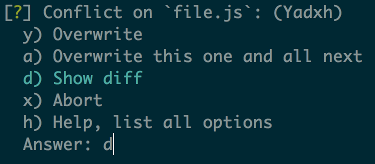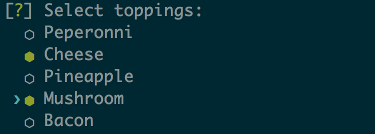A collection of common interactive command line user interfaces. It is originally called whaaaaaat created by finklabs, but due to bad naming and in need of fixes, I decided to rename and apply some necessary fixes on it. The reason is because I needed it for a tool that can be install through PyPI. I need to rewrite it for my own need. But don't worry any new fix on the main Repo, will be added to it if needed. Lastly, I am currently working on the author's TODO.
``PyInquirer`` strives to be an easily embeddable and beautiful command line interface for Python. ``PyInquirer`` wants to make it easy for existing Inquirer.js users to write immersive command line applications in Python. We are convinced that its feature-set is the most complete for building immersive CLI applications. We also hope that ``PyInquirer`` proves itself useful to Python users.
``PyInquirer`` should ease the process of - providing error feedback - asking questions - parsing input - validating answers - managing hierarchical prompts
Note: ``PyInquirer`` provides the user interface and the inquiry session flow. >
Like most Python packages PyInquirer is available on PyPi. Simply use pip to install the PyInquirer package
pip install PyInquirerIn case you encounter any prompt_toolkit error, that means you've the wrong prompt_toolkit version.
You can correct that by doing
pip install prompt_toolkit==1.0.14or download the wheel file from here:
https://pypi.org/project/prompt_toolkit/1.0.14/#filesLike Inquirer.js, using inquirer is structured into two simple steps:
- you define a list of questions and hand them to prompt
- promt returns a list of answers
from __future__ import print_function, unicode_literals
from PyInquirer import prompt, print_json
questions = [
{
'type': 'input',
'name': 'first_name',
'message': 'What\'s your first name',
}
]
answers = prompt(questions)
print_json(answers) # use the answers as input for your appA good starting point from here is probably the examples section.
Most of the examples intend to demonstrate a single question type or feature:
- bottom-bar.py
- expand.py
- list.py
- password.py
- when.py
- checkbox.py
- hierarchical.py
- pizza.py - demonstrate using different question types
- editor.py
- input.py
- rawlist.py
questions is a list of questions. Each question has a type.
Take type, name, message, choices[, default,
filter] properties. (Note that default must be the choice index
in the array or a choice value)
Take type, name, message, choices[, default,
filter] properties. (Note that default must the choice index in
the array)
Take type, name, message, choices[, default]
properties. (Note that default must be the choice index in the
array. If default key not provided, then help will be used as
default choice)
Note that the choices object will take an extra parameter called
key for the expand prompt. This parameter must be a single
(lowercased) character. The h option is added by the prompt and
shouldn't be defined by the user.
See examples/expand.py for a running example.
Take type, name, message, choices[, filter,
validate, default] properties. default is expected to be an
Array of the checked choices value.
Choices marked as {checked: true} will be checked by default.
Choices whose property disabled is truthy will be unselectable. If
disabled is a string, then the string will be outputted next to the
disabled choice, otherwise it'll default to "Disabled". The
disabled property can also be a synchronous function receiving the
current answers as argument and returning a boolean or a string.
Take type, name, message[, default] properties.
default is expected to be a boolean if used.
Take type, name, message[, default, filter,
validate] properties.
Take type, name, message[, default, filter,
validate] properties.
Take type, name, message[, default, filter,
validate] properties
Launches an instance of the users preferred editor on a temporary file. Once the user exits their editor, the contents of the temporary file are read in as the result. The editor to use is determined by reading the :math:`VISUAL or `EDITOR environment variables. If neither of those are present, notepad (on Windows) or vim (Linux or Mac) is used.
A question is a dictionary containing question related values:
- type: (String) Type of the prompt. Defaults: input - Possible values: input, confirm, list, rawlist, expand, checkbox, password, editor
- name: (String) The name to use when storing the answer in the answers hash. If the name contains periods, it will define a path in the answers hash.
- message: (String|Function) The question to print. If defined as a function, the first parameter will be the current inquirer session answers.
- default: (String|Number|Array|Function) Default value(s) to use if nothing is entered, or a function that returns the default value(s). If defined as a function, the first parameter will be the current inquirer session answers.
- choices: (Array|Function) Choices array or a function returning a choices array. If defined as a function, the first parameter will be the current inquirer session answers. Array values can be simple strings, or objects containing a name (to display in list), a value (to save in the answers hash) and a short (to display after selection) properties. The choices array can also contain a Separator.
- validate: (Function) Receive the user input and should return true if the value is valid, and an error message (String) otherwise. If false is returned, a default error message is provided.
- filter: (Function) Receive the user input and return the filtered value to be used inside the program. The value returned will be added to the Answers hash.
- when: (Function, Boolean) Receive the current user answers hash and should return true or false depending on whether or not this question should be asked. The value can also be a simple boolean.
- pageSize: (Number) Change the number of lines that will be rendered when using list, rawList, expand or checkbox.
TODO
``PyInquirer`` is build on prompt_toolkit which is cross platform, and everything that you build on top should run fine on both Unix and Windows systems. On Windows, it uses a different event loop (WaitForMultipleObjects instead of select), and another input and output system. (Win32 APIs instead of pseudo-terminals and VT100.)
It's worth noting that the implementation is a "best effort of what is possible". Both Unix and Windows terminals have their limitations. But in general, the Unix experience will still be a little better.
For Windows, it's recommended to use either cmder or conemu.
Most of the questions are probably related to using a question type or feature. Please lookup and study the appropriate examples.
Issue on Github TODO link
For many issues like for example common Python programming issues stackoverflow might be a good place to search for an answer. TODO link
## Contribution
Yes, you can contribute to this.
Since I am not the owner, it all goes to Finklab
Copyright (c) 2016-2017 Mark Fink (twitter: @markfink)
Copyright (c) 2018 Oyetoke Toby (twitter: @oyetokeT)
Licensed under the MIT license.






